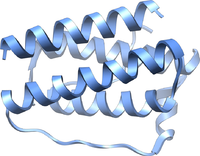
Photo from wikipedia
Bone is an endocrine organ that produces key hormones and cytokines (Green et al. 2015b). Paget’s disease of bone (PDB) is a polygenic disorder of bone turnover first described by… Click to show full abstract
Bone is an endocrine organ that produces key hormones and cytokines (Green et al. 2015b). Paget’s disease of bone (PDB) is a polygenic disorder of bone turnover first described by Sir James Paget in 1876. PDB is characterised by hyper differentiation and hyper activity of osteoclast cells which induces increased bone remodelling by osteoblasts. The resultant mosaic of bone is structurally weaker, larger, more vascular and porous with an increased susceptibility to fracture. On histology, the osteoclasts are increased in size, population and number of nuclei, expressing a ‘pagetic phenotype’ that distinguishes them from normal osteoclasts. Malignant transformation is a rare complication of PDB reported to arise in <1% of PDB patients. Paget’s associated osteosarcoma (PDB-OS) consistently arises in sites of pagetic bone and may present with multifocal lesions (Hansen et al. 2006). On histology the lesions are osteoblastic and characterised as an exaggerated form of the accelerated bone remodelling that manifests in PDB. Median survival at diagnosis is 21 months for those treated with curative intent and 7 months for those treated palliatively (Shaylor et al. 1999). PDB has a strong genetic component. A number of loci have been linked to the disorder with sequestosome 1 (SQSTM1) variants associated with more severe symptoms, polyostotic foci and heritable transmission (Hansen et al. 2006). SQSTM1 is multifunctional protein which serves as a signalling hub for diverse cellular events including activation of nuclear factor kappa B (NFKB) and tumour necrosis factor superfamily member 11 (TNFSF11). SQSTM1 also serves as an autophagy receptor for the degradation of ubiquitinated molecules via its ubiquitin binding domain (Katsuragi et al. 2015). SQSTM1 variants associated with PDB are typically located within the coding region of the ubiquitin binding domain. Impairment of autophagy is accompanied by the massive accumulation of SQSTM1 and formation of SQSTM1-positive aggregate structures (Katsuragi et al. 2015). As the role of SQSTM1 has not been fully elucidated in transformation and there is no transcriptomic analysis of this cancer, we took a next generation sequencing approach to evaluate the expression of small RNAs such as microRNAs (miRNAs) in PDB and PDB-OS. MiRNAs are key regulators of gene expression through gene silencing. MiRNAs can also be used as biomarkers to classify poorly differentiated cancers and cancer tissue origin (Green et al. 2015a). We extracted RNA using the miRCURY RNA isolation kit (Exiqon) from two tissue specimens of PDB-OS with a proven histological diagnosis of osteosarcoma in Paget’s affected bone (ages 73 and 81, 2 men). We extracted RNA from four SQSTM1-positive PDB tissue specimens obtained from affected trabecular bone (ages 79–87, 2 women and 2 men). We extracted RNA from five control bone tissue specimens obtained from the femoral heads of trauma patients (ages 68–86, 3 women and 2 men). Tissue samples were collected and preserved at −20°C. RNA was stored at −80°C. We generated small RNA libraries using high definition (HD) adapters as previously described (Xu et al. 2015). HD adapters increase the annealing efficiency between small RNAs and adapters. An increased annealing efficiency significantly reduces the RNA ligase-dependent ligation bias in next generation sequencing studies (Xu et al. 2015). We performed sequencing on the HiSeq 2500 Ultra-HighThroughput Sequencing System (Illumina) at the Earlham Institute, Norwich Research Park. Raw fastq files were converted to fasta format. The HD signatures of the sequencing reads were trimmed. Quality checking was performed using The UEA Small RNA Workbench (www.srna-workbench.cmp.uea.ac.uk). Reads were mapped with no gaps allowed to the human genome v38 using PatMaN. Small RNA expression levels were normalised using a scaling approach, reads per total, to a fixed total of 10 million reads (Mohorianu et al. 2011). Comparison of the samples was conducted using scatter plots, size-split boxplot of the replicate-to-replicate